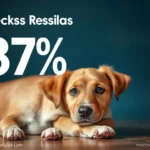
Introduction
Understanding dog communication is essential for any dog owner who wishes to foster a strong bond with their furry friend. It encompasses all the ways dogs convey their feelings, needs, and desires—both verbally and non-verbally. By recognizing and interpreting these signals, owners can improve their relationships with their dogs, ensuring a harmonious coexistence. This article will delve into the various aspects of canine communication, including body language, vocalizations, and the importance of socialization, alongside practical tips for enhancing communication with your dog.
The Basics of Dog Communication
Types of Communication
Dogs communicate through a mix of verbal and non-verbal signals.
-
Verbal communication includes sounds like barks, growls, and whines. Each vocalization has its own meaning and significance, which we will explore further in this article.
-
Non-verbal communication involves body language and facial expressions. Dogs often convey their emotions through their posture, movements, and even the position of their ears and tails.
The Role of Context
Context is crucial in understanding dog communication. The environment in which a dog is situated can significantly affect its behavior and the signals it sends. For instance, a dog may bark excitedly at a friend in a park but may growl defensively if approached in a more confined space. Understanding the situation behind a dog’s behavior can provide insight into its needs and feelings.
Understanding Canine Body Language
Postures and Movements
Dogs exhibit a variety of postures that indicate their emotional state:
-
Aggressive posture: A dog may stand tall, with its ears erect and tail raised. This stance usually means the dog feels threatened or is trying to assert dominance.
-
Submissive posture: Conversely, a dog that is feeling submissive may lower its body, tuck its tail, and avoid direct eye contact. This behavior signals respect or a desire to avoid conflict.
-
Playful behaviors: Dogs often display a “play bow,” where they lower their front legs while keeping their hindquarters elevated. This gesture invites interaction and signals playful intentions.
Tail Position and Movement
The position and movement of a dog’s tail are key indicators of its emotional state:
-
High tail: A tail held high often signifies confidence and happiness.
-
Low tail: A tail hanging low may indicate uncertainty or submission.
-
Tucked tail: A tail tucked between the legs usually suggests fear or anxiety.
-
Tail wagging: The speed and direction of wagging can convey different meanings. A fast wagging tail might indicate excitement, while a slow wag could suggest caution.
Ear and Eye Signals
Ears and eyes are also critical components of dog communication:
-
Ear positions: Ears held forward can indicate curiosity or attentiveness, whereas ears pulled back may reflect fear or submission.
-
Eye contact: Direct eye contact can be interpreted as a challenge or aggression, while a soft gaze or blinking may signify relaxation and trust.
Vocalizations and Their Meanings
Barking
Barking is one of the most common forms of dog communication and can be categorized into different types based on context:
-
Alert bark: A sharp, loud bark usually signals a warning about potential threats.
-
Playful bark: A higher-pitched bark may indicate excitement and eagerness to engage in play.
-
Aggressive bark: A deep, growling bark often serves as a warning to stay away.
Understanding the tone and frequency of barks can help owners respond appropriately to their dog’s needs.
Growling
Growling can be misunderstood by many. It is often considered a warning signal, but it can also have playful connotations:
-
Warning growl: A low growl often indicates that a dog feels threatened or wants to assert dominance.
-
Playful growl: If accompanied by a wagging tail and playful posture, it may simply mean the dog is having fun.
Recognizing the context behind growling is vital for appropriate interpretation.
Other Sounds
Dogs also communicate through other vocalizations like whining and howling:
-
Whining: This sound often indicates discomfort, anxiety, or a desire for attention. It can be an indication that the dog needs something, such as food or to go outside.
-
Howling: Often a response to certain sounds, howling may signal loneliness or serve as a way to communicate with other dogs.
Understanding these sounds in their respective contexts can enhance the owner-dog relationship.
The Importance of Socialization
Early Socialization
Early socialization is crucial for puppies to develop effective dog communication skills. Puppies that are exposed to various environments, people, and other animals learn how to interpret and respond to different signals. Here are some tips for socializing puppies:
-
Positive experiences: Introduce your puppy to new experiences gradually, ensuring they are positive and non-threatening.
-
Diverse interactions: Encourage interactions with different people and calm, friendly dogs to help your puppy learn appropriate social cues.
Ongoing Socialization
Socialization shouldn’t stop after puppyhood. Adult dogs need continued exposure to various situations to maintain their communication skills. Here are some activities to promote ongoing socialization:
-
Group training classes: These provide an environment for dogs to interact with others while learning commands.
-
Dog parks: Supervised visits to dog parks can help dogs practice their communication skills in a social setting.
Common Misinterpretations
Human Misinterpretations
Humans often misread dog communication signals, leading to misunderstandings. Some common misconceptions include:
-
Aggression vs. play: A dog growling during play may be misinterpreted as aggressive behavior, causing unnecessary concern.
-
Submission as fear: Some owners may mistake a submissive posture for fear, not realizing the dog is simply displaying respect.
Understanding these misinterpretations is key to fostering a better relationship with your dog.
Consequences of Misinterpretation
Misunderstanding a dog’s signals can have negative consequences on behavior and the owner-pet relationship. For instance, misinterpreting a dog’s growl may lead to increased anxiety in the dog, further escalating behavioral issues. To avoid these misunderstandings, owners should:
-
Educate themselves: Learning about canine body language and vocalizations can help prevent misinterpretations.
-
Stay observant: Pay close attention to your dog’s overall demeanor and context before reacting to their behaviors.
Enhancing Communication with Your Dog
Building Trust and Understanding
To improve dog communication, building trust is essential. Here are some techniques for fostering a strong bond:
-
Consistent training: Regular training sessions help establish clear communication between you and your dog, reinforcing desired behaviors.
-
Positive reinforcement: Rewarding your dog for good behavior promotes trust and encourages them to communicate more openly.
Training Tips for Better Communication
Training is a crucial aspect of enhancing dog communication. Here are some effective tips:
-
Clear commands: Use simple, consistent commands so your dog can easily understand what you expect.
-
Cues for interaction: Teach your dog specific cues for different activities, such as “sit” for attention or “come” for playtime.
Observing and Responding to Your Dog
Being attentive to your dog’s signals is vital for effective communication. Here are some practical tips:
-
Watch for signals: Regularly observe your dog’s body language and vocalizations to understand their needs better.
-
Adjust your responses: Tailor your reactions based on your dog’s communication, ensuring that they feel heard and understood.
Case Studies and Real-Life Examples
Anecdotes from Dog Owners
Many dog owners have experienced the transformation that comes from understanding dog communication:
-
Story 1: One owner realized their dog’s growling during playtime was not a sign of aggression but rather an expression of excitement. By adjusting their response, they were able to enhance playtime interactions.
-
Story 2: Another dog owner learned to recognize their dog’s anxious whines as a request for companionship. By providing comfort during stressful situations, they strengthened their bond.
Expert Insights
Veterinarians and dog trainers often share valuable insights into dog communication:
-
Quote from a trainer: “Understanding your dog’s body language can help you respond more effectively to their needs, creating a more harmonious relationship.”
-
Professional advice: Trainers recommend regular socialization and training to improve communication skills, emphasizing that a well-understood dog is a happy dog.
Conclusion
Understanding dog communication is crucial for creating a strong and loving bond with your canine companion. By paying attention to their body language, vocalizations, and context, you can better respond to their needs and emotions. Observing and adapting your responses fosters trust and encourages open communication. As you deepen your understanding of your dog’s signals, you’ll find that your relationship becomes more fulfilling and enjoyable. The journey of learning about dog communication is ongoing, and with patience and attentiveness, you can create a lasting connection with your beloved pet.









